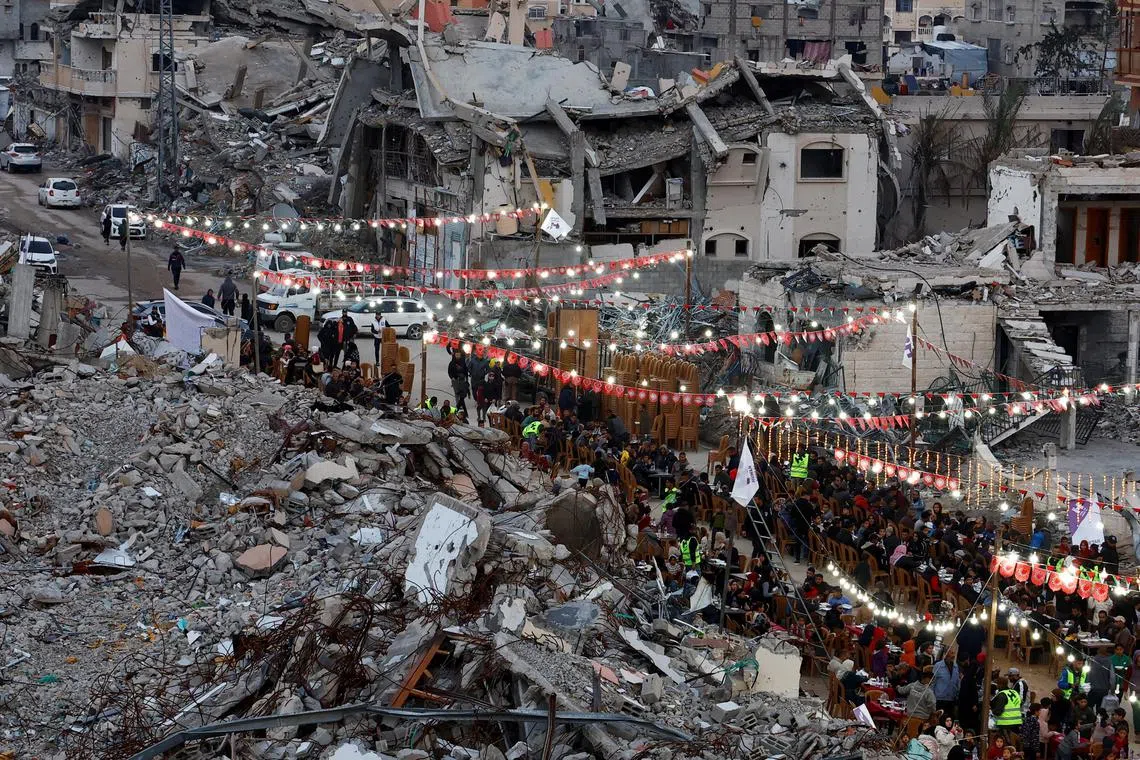‘Steadfast’ Gazans begin second Ramadan among rubble
Sign up now: Get ST's newsletters delivered to your inbox

Palestinians breaking their fast during the Muslim holy month of Ramadan in Rafah, in the southern Gaza Strip, on March 1.
PHOTO: REUTERS
Follow topic:
RAFAH, Palestinian Territories - A red-covered table stretching several hundred metres carved a path through mounds of rubble in southern Gaza on March 1, as families gathered to break their fast during the first day of the Muslim fasting month of Ramadan.
As the sun set over a neighbourhood in Rafah, where fighting between Israel and Palestinian militants has left barely a handful of buildings standing, hundreds of Gazans of all ages dug into the iftar meal marking the end of the day’s fast.
“People are deeply saddened, and everything around us feels heartbreaking,” said Ms Malak Fadda, who had organised the communal meal.
“So, we decided to bring joy back to this street, just as it was before the war.”
As the crowd sat down to eat, uncertainty loomed over the next stages of the Gaza ceasefire, the first phase of which was drawing to a close on March 1 after largely bringing an end to more than 15 months of fighting.
A second stage is supposed to pave the way for a more permanent end to the war, and early on March 2, the office of Israeli Prime Minister Benjamin Netanyahu announced a temporary ceasefire in Gaza for the Ramadan and Passover periods.
Music wafted from loudspeakers through the crowd in Rafah, who sat on a long row of plastic chairs under bunting, Palestinian flags and lights strung between broken concrete.
The war sparked by Palestinian militant group Hamas’ Oct 7, 2023, attack on Israel has left over 69 per cent of Gaza’s buildings damaged or destroyed.
Israeli bombardment or fighting has displaced almost the entire Gazan population and triggered widespread hunger, according to the United Nations.
The truce that took effect on Jan 19 has enabled greater aid flows into the devastated Palestinian territory, but hundreds of thousands continue to live in tents, with many camped out in the rubble of their former homes.
Rafah resident Umm al-Baraa Habib told AFP: “On the first day of Ramadan, we had hoped to return to our houses to break our fast with our families and be together at our homes.
“But this is God’s will, and we remain steadfast.”
‘Sit among destruction’
In the northern city of Beit Lahia, dozens defiantly joined together in the fading evening light to break their fast among the remnants of half-collapsed buildings.
Mr Mohammed Abu Al-Jidyan said: “We are here in the midst of destruction and rubble, and we are steadfast despite the pain and our wounds. Here we are eating Iftar on our land and we will not leave this place.”
US President Donald Trump has floated an idea for a US takeover of Gaza, under which its Palestinian population would be relocated – a proposal met with global condemnation.
Before the break of dawn in the southern city of Khan Younis, fluorescent pink, yellow and blue lights illuminated a largely war-destroyed neighbourhood where a small crowd had gathered for the sahur meal, eaten ahead of fasting.
A mural reading “Ramadan brings us together” with a crescent moon was painted on one of the walls left standing.
The day before, young people had hung colourful Ramadan lanterns, flags and decorations between the rubble, while vendors displayed balloons and toys for children.
But the usual joy of the Muslim holy month has brought little hope to many of Gaza’s war displaced.
Mr Omar al-Madhoun, a resident of the hard-hit Jabalia camp in north Gaza, said: “My children sometimes ask me for clothes and food, but I can’t provide for them because I have been out of work for a year and a half.”
“We sit among the destruction, not knowing how to manage our lives. We also fear that the war will return, bringing even more destruction,” he told AFP on Feb 28, the day the start of Ramadan was announced.
Hamas’ attack on Israel that sparked the Gaza war resulted in the deaths of 1,218 people, mostly civilians, according to an AFP tally of official figures.
Israel’s retaliation has killed 48,388 people in Gaza, a majority of them civilians, according to the Health Ministry in the Hamas-run territory whose figures the UN has deemed reliable.
The first phase of the truce has seen Hamas free 25 living hostages and return the bodies of eight others to Israel in exchange for more than 1,700 Palestinian prisoners. AFP

